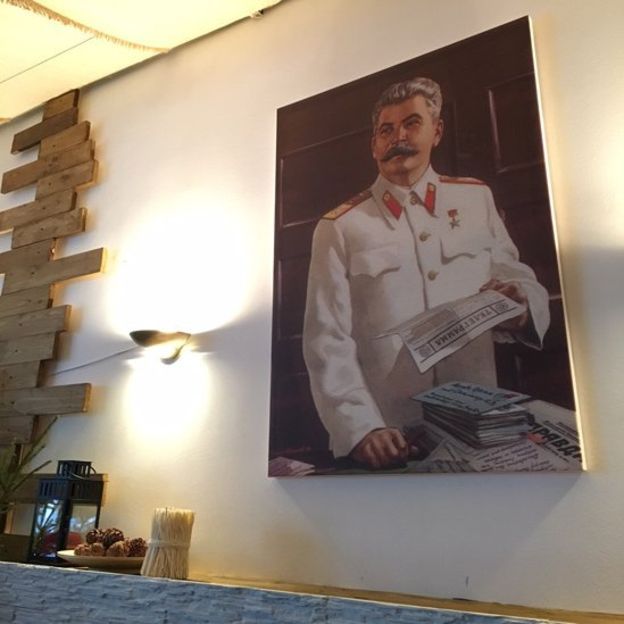
自由工作者,兼職文化遊領隊,也接翻譯文案,走過約60個國家。商學院製造,但興趣是政史哲及踩單車去旅行,也喜歡攝影和打機。 文字看累了,也可以逛一下我的小實驗 Youtube 頻道:https://bit.ly/3grewx4
Even if there are no photos of the restaurant, we are eating man-made buns
When I visited Nur-Sultan, the capital of Kazakhstan, I visited a Soviet-style restaurant filled with various Soviet relics. There is no shortage of sickles and hammers, as well as military uniforms, machine guns, portraits of Soviet leaders, and huge coins engraved with Lenin's head, attracting many tourists to pilgrimage.

The Russians are even more "aggressive". In 2016, a new restaurant opened in Moscow called NKVD (People's Commissariat of Internal Affairs), the predecessor of the secret police agency KGB. In addition to a pile of Soviet badges, a portrait of Stalin hangs in the restaurant. Stalin was recognized as a murderer, and the restaurant naturally aroused the disgust of many citizens, and even the BBC went to interview him. In the end, the restaurant removed the sign in front of the door to avoid being too ostentatious, but it was still open for business as usual.

For many former Soviet Union countries, the Soviet Union is a totem of disaster. Opening a restaurant to consume disasters is indeed easy to cause public outrage. Then if the topic is put into a museum, and all kinds of disaster images and photos of victims are displayed grandly, is it safe and sound?
American writer Susan. Sangeta is very concerned with the meaning of images of suffering. She rhetorically asked in "The Pain of Bystanders", is the disaster photo to teach us a lesson and make us strong in the face of our inner weakness, or it can only make us feel numb, or even become a tool for our own satisfaction? When we look at disaster photos, do we feel a sense of unanimous sympathy? What can sympathy do, and what can it not do?
Sangerta's view is pessimistic. She believes that each viewer will interpret the same grim photo differently based on their own experience, cultural background, political stance, and ideology. Take images of war, for example. Photos without bones evoke the brutality of war, but do not necessarily convince viewers that they are anti-war. Some people believe that the world is already torn apart, or that there are just wars in the world. They will think that the sacrifice and honor of participating in the war has its meaning and is worthy of admiration. Audiences with different backgrounds and positions have different reactions to the sadness that greets them. It could be resentment, anger, approval, or even addiction. Sympathy is extremely difficult to exist.
In fact, our sympathy can only be based on our own experience and imagination. But who can imagine the pain of a bullet going through the eyeball, and the desperation of feeling the sea water pouring into the lungs? I can't even imagine the pressure of ten years in prison. Sympathy and empathy are extremely limited. It might even be said that we are doomed to watch the suffering of others.
What if we could all "empathize" with grief for suffering and pity for the dead?
“When we feel compassion, we don’t think we are accomplices in suffering. We use compassion to declare ourselves innocent and powerless at the same time. Even if we have good intentions, it is inappropriate and even arrogant to respond with compassion in this way.” Sangeta If so.
Even mercy is wrong? Neither. Sangeta added: "Compassion is an unstable emotion that withers if not acted upon. The question is how to deal with the emotions that are moved, the knowledge that is passed on?"
Sangeta is not against mercy, she is against the "only" mercy of the bystander. Mercy without action is cheap. When we see suffering happen, if we can only respond with a sigh and then withdraw from it, this kind of bystander is just consumption.
In fact, regardless of pity, anger, criticism, or even contempt, is it not a kind of consumption? The ground is red, who can't be stained with a little blood? If there really is original sin in the world, the guilt must be man-eating buns. Original sin is innate, and it is up to you to choose whether or not you can eat man-made buns. The most excessive, it should be blood dripping from the corners of his mouth, thinking that he is innocent and laughing at others' ugly appearance. The point is when you admit that you're a bloodbath and you're willing to pay for it.
In this way, perhaps we can be a little more lenient to the accomplices around us and restrain ourselves a little bit, hoping that the images of suffering can enjoy the tranquility on the grass as soon as possible, instead of watching the world in the foreshadowing. This may be the only tribute that can be done.
Like my work?
Don't forget to support or like, so I know you are with me..
Comment…